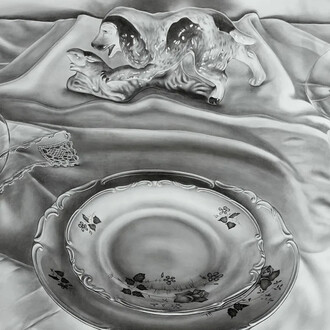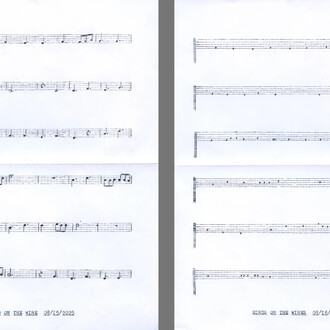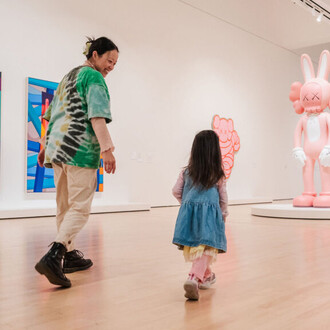Catharine Clark Gallery continues its Winter 2019 program with "An Inexhaustive Study of Power," an exhibition of solo and collaborative works by Andy Diaz Hope and Laurel Roth Hope. Throughout their respective careers, Diaz Hope and Roth Hope have created work that responds to the environment and conservation, the dissemination of information through mass media, and the relationship between narrative and spirituality, often through mixed media and installation. "An Inexhaustive Study of Power" imagines an immersive space that employs “the aesthetics of a richly appointed apartment overlooking a world on the brink of societal collapse.”
For this exhibition, Diaz Hope and Roth Hope reference design elements found in sources as myriad as presidential portraits and religious art, raising questions about how power is evoked and reified through visual forms. The artists note that “we have recently begun to realize that a growing undercurrent in our work, both collaboratively and individually, has to do with power – who has it, how it is built into systems, how it changes over time, and who benefits from it.” For their exhibition, Diaz Hope and Roth Hope transform the gallery into a suite of decorated and furnished rooms, with overt nods to the ornamental style found across countless “selfie-ready” social media posts. While seamlessly blending in with their surroundings, their artworks invite deeper – and occasionally darkly humorous – reflection, on the political, psycho-social, and environmental costs of material adornment.
Roth Hope’s "Reliquary for Biodiversity" (2018), for example, features a ceramic bust of a gorilla, its neck encircled with a wreath of gold-glazed ceramic birds. While unquestionably stunning in its high craft, Roth Hope’s sculpture evokes unsettling traditions of trophy hunting and poaching that have rendered many animal species – including the gorilla – endangered or extinct.
In Diaz Hope’s triptych, "We Are Special" (2018 – 19), the official Presidential photographic portraits of Barack Obama and Donald Trump are rendered in gel pill capsules, their images ensconced in ornate-gold frames that bookend a central panel: a framed mirror. In referencing the ostentatious display of political portraiture, the work encourages reflection on how visual cultures reify authority, while also asking viewers to question their personal relationship to ongoing debates around the cost of pharmaceuticals and healthcare, and whether access is a universal right or an earned privilege. By placing the mirror between the portraits of Obama and Trump, Diaz Hope suggests that these debates require personal reflection by individuals, rather than blind adherence to partisan politics.
By comparison, a group of bullet-ridden “windows” lit by colored LED lights evokes images of nighttime constellations, as well as discourse on gun violence, individual rights, and the future. Conversely, Diaz Hope’s multi-faceted mirror sculpture, "Beautiful Void: Sky" (2017), and Roth Hope’s gilded wreaths of porcelain starlings, "Manifest Destiny #1 – 2" (all 2017) reimagine forms and patterns from various religions – including Christian ecclesiastical architecture and Islamic art – to draw out relationships between power and aesthetics, particularly through a visual language associated with faith.
"An Inexhaustive Study of Power" is complemented by a media room presentation of "People in Order – Home" (2006), a collaborative video by Lenka Clayton and James Price. Produced immediately prior to the financial crisis of the mid-2000s, the video features 73 households in Great Britain, arranged in descending order of annual income. While ostensibly playful, the video considers how we collectively assess material well-being and security by exploring how income stratification shapes our definition of “home.” Catharine Clark Gallery presents "People in Order – Home" in advance of Lenka Clayton’s debut solo exhibition at the gallery, "Won, Too, Free, For," opening April 6, 2019.
















